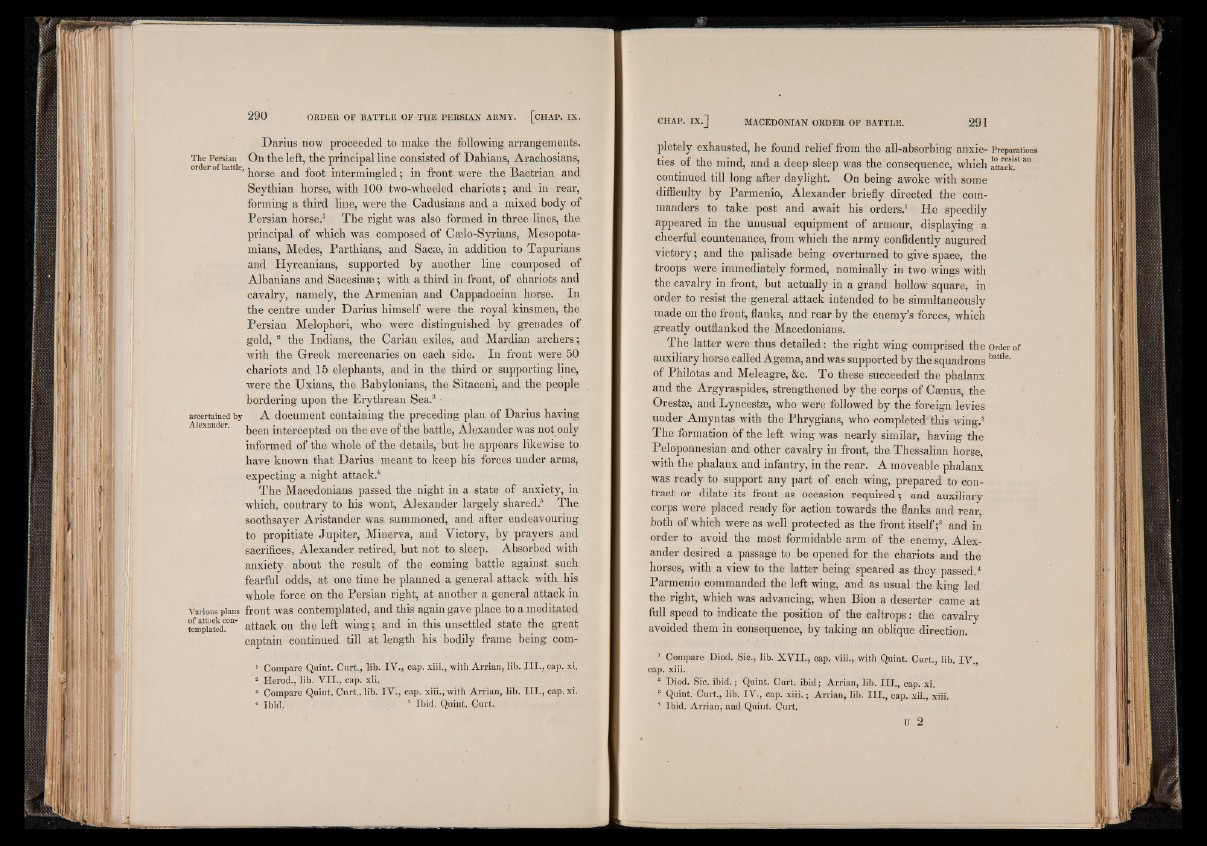
Darius now proceeded to make the following arrangements.
The Persian On the left, the principal line consisted of Dahians, Arachosians,
’ horse and foot intermingled; in front were the Bactrian and
Scythian horse, with 100 two-wheeled chariots; and in rear,
forming a third line, were the Cadusians and a mixed body of
Persian horse.1 The right was also formed in three lines, the
principal of which was composed of Cselo-Syrians, Mesopotamians,
Medes, Parthians, and Sacae, in addition to Tapurians
and Hyrcanians, supported by another line composed of
Albanians and Sacesinae; with a third in front, of chariots and
cavalry, namely, the Armenian and Cappadocian horse. In
the centre under Darius himself were the royal kinsmen, the
Persian Melophori, who were distinguished by grenades of
gold, 2 the Indians, the Carian exiles, and Mardian archers ;
with the Greek mercenaries on each side. In front were 50
chariots and 15 elephants, and in the third or supporting line,
were the Uxians, the Babylonians, the Sitaceni, and the people
bordering upon the Erythrean Sea.3 -
ascertained by A document containing the preceding plan of Darius having
Alexander. k e e n intercepted on the eve of the battle, Alexander was not only
informed of the whole of the details, but he appears likewise to
have known that Darius meant to keep his forces under arms,
expecting a night attack.4
The Macedonians passed the night in a state of anxiety, in
which, contrary to his wont, Alexander largely shared.5 The
soothsayer Aristander was summoned, and after endeavouring
to propitiate Jupiter, Minerva, and Victory, by prayers and
sacrifices, Alexander retired, but not to sleep. Absorbed with
anxiety about the result of the coming battle against such
fearful odds, at one time he planned a general attack with his
whole force on the Persian right, at another a general attack in
various plans front was contemplated, and this again gave place to a meditated
tempted““' attack on the left wing; and in this unsettled state the great
captain continued till at length his bodily frame being com1
Compare Quint. Curt., lib. IV.,. cap. xiii., with Arrian, lib. I I I . , cap. xi.
2 Herod., lib. Y I I ., cap. xli.
3 Compare Quint. Curt., lib. IV ., cap. xiii., with Arrian, lib. I I I ., cap. xi.
4 Ibid. i 5 Ibid. Quint. Curt.
pletely exhausted, he found relief from the all-absorbing anxie- Preparations
ties of the mind, and a deep sleep was the consequence, which attack.81 m
continued till long after daylight. On being awoke with some
difficulty by Parmenio, Alexander briefly directed the commanders
to take post and await his orders.1 He speedily
appeared in the unusual equipment of armour, displaying a
cheerful countenance, from which the army confidently augured
victory; and the palisade being overturned to give space, the
troops were immediately formed, nominally in two wings with
the cavalry in front, but actually in a grand hollow square, in
order to resist the general attack intended to be simultaneously
made on the front, flanks, and rear by the enemy’s forces, which
greatly outflanked the Macedonians.
The latter were thus detailed: the right wing comprised the Order of
auxiliary horse called Agema, and was supported by the squadrons battIe'
of Philotas and Meleagre, &c. To these succeeded the phalanx
and the Argyraspides, strengthened by the corps of Camus, the
Orestse, and Lyncestse, who were followed by the foreign levies
under Amyntas with the Phrygians, who completed this wing.2
The formation of the left wing was nearly similar, having the
Peloponnesian and other cavalry in front, the Thessalian horse,
with the phalanx and infantry, in the rear. A moveable phalanx
was ready to support any part of each wing, prepared to contract
or dilate its front as occasion required; and auxiliary
corps were placed ready for action towards the flanks and rear,
both of which were as well protected as the front itself;3 and in
order to avoid the most formidable arm of the enemy, Alexander
desired a passage to be opened for the chariots and the
horses, with a view to the latter being speared as they passed.4
Parmenio commanded the left wing, and as usual the king led
the right, which was advancing, when Bion a deserter came at
full speed to indicate the position of the caltrops: the cavalry
avoided them in consequence, by taking an oblique direction.
1 Compare Diod. Sic., lib. X V I I ., cap. viii., with Quint. Curt., lib. IV .
cap. xiii.
2 Diod. Sic. ib id .; Quint. Curt, ib id ; Arrian, lib. I I I ., cap. xi.
3 Quint. Curt., lib. IV., cap. xiii. -r Arrian, lib. I I I ., cap. xii., xiii.
4 Ibid. Arrian, and Quint. Curt.
H 2